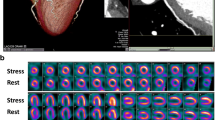Abstract
Objective The aim of this study was to compare the diagnostic accuracy of myocardial perfusion imaging (MPI) by positron emission tomography (PET) with the diagnostic accuracy of MPI by single photon emission computed tomography (SPECT) in two comparable patient cohorts, using coronary angiography (CA) as the standard of reference. Methods A “SPECT-group” of 80 patients (15 female, 65 male; mean age 60 ± 9 years) and a “PET-group” of 70 patients (14 female, 56 male; mean age 57 ± 10 years) underwent a one day stress/rest examination either with attenuation-corrected 13N-ammonia PET or attenuation-corrected 201TlCl SPECT or 99mTc-hexakis-methoxy-isobutyl-isonitril (MIBI) SPECT. PET and SPECT results were semiquantitatively graded using a 6-segment heart model. All patients underwent CA, and stenoses were graded as a diameter reduction ≥50%. Results Coronary findings between both groups did not significantly differ at CA. For the SPECT-group overall sensitivity and specificity for localisation of stenoses was 77% and 84%. Respective values for the PET-group were 97% and 84%. The specificity of MPI by SPECT in the detection of ischemia was 74% and 91% for MPI by PET. The diagnostic accuracy of MPI improves when the individual coronary dominance and previous coronary revascularisations are taken into account. Conclusion MPI by 13N-ammonia PET is more sensitive in the detection and localisation of coronary stenoses, and more specific in the detection of ischemia than MPI by 201TlCl/99mMIBI SPECT.



Similar content being viewed by others
Abbreviations
- CA:
-
Coronary angiography
- CAD:
-
Coronary artery disease
- MPI:
-
Myocardial perfusion imaging
- PET:
-
Positron emission tomography
- SPECT:
-
Single photon emission computed tomography
References
Tamaki N, Yonekura Y, Senda M et al (1988) Value and limitation of stress thallium-201 single photon emission computed tomography: comparison with nitrogen-13 ammonia positron tomography. J Nucl Med 29:1181–1188
Di Carli MF, Hachamovitch R (2007) New technology for noninvasive evaluation of coronary artery disease. Circulation 115:1464–1480
Klocke FJ, Baird MG, Lorell BH et al (2003) ACC/AHA/ASNC guidelines for the clinical use of cardiac radionuclide imaging—executive summary: a report of the American College of Cardiology/American Heart Association Task Force on Practice Guidelines (ACC/AHA/ASNC Committee to Revise the 1995 Guidelines for the Clinical Use of Cardiac Radionuclide Imaging). J Am Coll Cardiol 42:1318–1333
Slart RH, Bax JJ, van Veldhuisen DJ, van der Wall EE, Dierckx RA, Jager PL (2006) Imaging techniques in nuclear cardiology for the assessment of myocardial viability. Int J Cardiovasc Imaging 22:63–80
Stewart RE, Schwaiger M, Molina E et al (1991) Comparison of rubidium-82 positron emission tomography and thallium-201 SPECT imaging for detection of coronary artery disease. Am J Cardiol 67:1303–1310
Go RT, Marwick TH, MacIntyre WJ et al (1990) A prospective comparison of rubidium-82 PET and thallium-201 SPECT myocardial perfusion imaging utilizing a single dipyridamole stress in the diagnosis of coronary artery disease. J Nucl Med 31:1899–1905
Marwick TH, Go RT, MacIntyre WJ, Saha GB, Underwood DA (1991) Myocardial perfusion imaging with positron emission tomography and single photon emission computed tomography: frequency and causes of disparate results. Eur Heart J 12:1064–1069
Bateman TM, Heller GV, McGhie AI et al (2006) Diagnostic accuracy of rest/stress ECG-gated Rb-82 myocardial perfusion PET: comparison with ECG-gated Tc-99 m sestamibi SPECT. J Nucl Cardiol 13:24–33
Di Carli MF, Hachamovitch R (2006) Should PET replace SPECT for evaluating CAD? The end of the beginning. J Nucl Cardiol 13:2–7
Lee SJ, Lee KH, Park SM et al (2007) Myocardial perfusion defects and coronary risk factors in symptomatic and asymptomatic elderly women. Int J Cardiovasc Imaging
Koepfli P, Wyss CA, Namdar M et al (2004) Beta-adrenergic blockade and myocardial perfusion in coronary artery disease: differential effects in stenotic versus remote myocardial segments. J Nucl Med 45:1626–1631
Margonato A, Chierchia SL, Xuereb RG et al (1995) Specificity and sensitivity of exercise-induced ST segment elevation for detection of residual viability: comparison with fluorodeoxyglucose and positron emission tomography. J Am Coll Cardiol 25:1032–1038
Austen WG, Edwards JE, Frye RL et al (1975) A reporting system on patients evaluated for coronary artery disease. Report of the Ad Hoc Committee for Grading of Coronary Artery Disease, Council on Cardiovascular Surgery, American Heart Association. Circulation 51:5–40
Fagret D, Marie PY, Brunotte F et al (1995) Myocardial perfusion imaging with technetium-99 m-Tc NOET: comparison with thallium-201 and coronary angiography. J Nucl Med 36:936–943
Berman DS, Kiat H, Friedman JD et al (1993) Separate acquisition rest thallium-201/stress technetium-99 m sestamibi dual-isotope myocardial perfusion single-photon emission computed tomography: a clinical validation study. J Am Coll Cardiol 22:1455–1464
Hor G, Sebening H, Sauer E et al (1979) 201Tl-redistribution analysis in early and delayed myocardial scintigrams of patients with coronary heart disease (CHD). Eur J Nucl Med 4:343–350
Garcia EV, Eisner RL, Patterson RE (1993) What should we expect from cardiac PET? J Nucl Med 34:978–980
Heller GV, Bateman TM, Johnson LL et al (2004) Clinical value of attenuation correction in stress-only Tc-99 m sestamibi SPECT imaging. J Nucl Cardiol 11:273–281
Links JM, DePuey EG, Taillefer R, Becker LC (2002) Attenuation correction and gating synergistically improve the diagnostic accuracy of myocardial perfusion SPECT. J Nucl Cardiol 9:183–187
Masood Y, Liu YH, Depuey G et al (2005) Clinical validation of SPECT attenuation correction using X-ray computed tomography-derived attenuation maps: multicenter clinical trial with angiographic correlation. J Nucl Cardiol 12:676–686
Author information
Authors and Affiliations
Corresponding author
Rights and permissions
About this article
Cite this article
Husmann, L., Wiegand, M., Valenta, I. et al. Diagnostic accuracy of myocardial perfusion imaging with single photon emission computed tomography and positron emission tomography: a comparison with coronary angiography. Int J Cardiovasc Imaging 24, 511–518 (2008). https://doi.org/10.1007/s10554-007-9288-7
Received:
Accepted:
Published:
Issue Date:
DOI: https://doi.org/10.1007/s10554-007-9288-7




